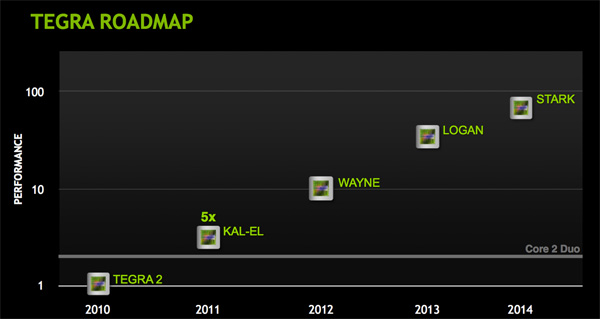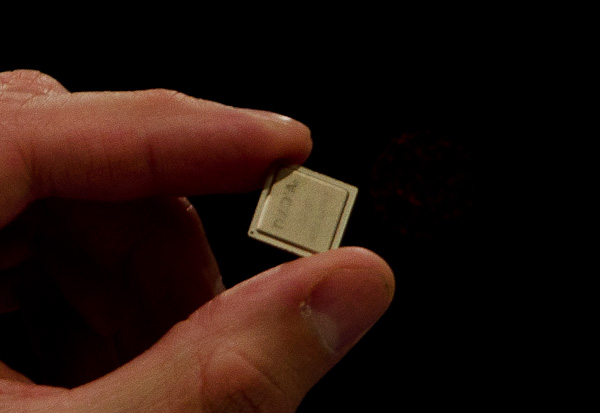NVIDIA's Kal-El Glowball Shows off Dynamic Lighting & Quad-Core Physics on a Tablet
by Anand Lal Shimpi on May 29, 2011 11:00 PM ESTI've warned both Qualcomm and TI that the danger they have to face in the SoC space going forward isn't just NVIDIA engineering, but NVIDIA marketing. Although too aggressive for my tastes at times, NVIDIA does know how to take a simple product release and turn it into an extremely polished technology launch. Even down to the materials NVIDIA shares with the press, to-date none of its competitors have built such pretty slides that make their way all over the web.
Obviously it's not just marketing with NVIDIA. After a rough start the Tegra 2 finally got real traction and has been the premier Android smartphone and tablet SoC since the beginning of the year. If you're buying an Android smartphone or tablet today, chances are the best option uses Tegra 2.
At MWC earlier this year NVIDIA announced its third applications processor, codenamed Kal-El. Kal-El will feature four ARM Cortex A9 cores with a shared 1MB L2 cache and MPE/NEON support (absent from Tegra 2). Kal-El will also fix the video decoder issue we've run into on Tegra 2 and should be able to play all high profile H.264 content with proper OS support. On top of all of that there's a faster GPU (12-core vs. 8-core plus higher throughput per core).

What does all of this have to do with NVIDIA's marketing? Today NVIDIA posted one of its famous tech demos running on a Kal-El reference platform to show off what's possible with the new SoC:
The video shows the output from a Honeycomb Kal-El development platform. In it you see techniques such as dynamic lighting and real-time physics. The latter uses all four of Kal-El's A9 cores, which you can see in action in the lower left of the video.
The Glowball demo is the perfect example of NVIDIA knowing how to execute on both the product and marketing sides when it comes to any major launch. Kal-El is still months away, but this is a great way to build excitement.
As always it's a pretty impressive tech demo but it's just that, a demo. As we've seen in the past, NVIDIA's tech demos are usually far more impressive than the actual titles we see released in the near term. After all, it's always easier to make a single scene look great vs. an entire game (not to mention that performance requirements go up as you add more dynamic characters in a given scene). But as a demo of what will be possible on a tablet by the end of the year, I can't complain.
NVIDIA said that Kal-El based devices are on track for release this holiday season. The original commitment was August 2011 but NVIDIA wouldn't be any more specific than to say that we may see some products launch before the holidays.

I suspect we may see more on Kal-El at Computex next week.












51 Comments
View All Comments
Moz316 - Wednesday, June 1, 2011 - link
Oh boy.. Where to start..What market is becoming more of a niche? The modern game market? The one worth more than Hollywood?
PC market not so big anymore? You mean the PC market that continues to grow each year through digital distribution of titles? Or am I missing something?
Why have games stagnated? Oh yes, it must be becasue of notebooks.. not because of developers devoting most of their time into games for consoles and then porting them over to pc.
Don't quit your day job... whatever that is.
cotak - Monday, May 30, 2011 - link
Yeah I'll wait till people get their hands on real devices to test before I get excited. Smells a bit like a lot of other tech demo launches done in the past that promises more than they can deliver.Tegra 2 has hardly got any traction and they already planning august 2011 launch for it's replacement. And a quad core for battery limited devices? Seems weird.
What I mean is tegra 2 OEMs haven't even made their money off their tegra 2 devices and nvidia already wants them to go to a quad core version? I guess that can work for the market in Asia where electronic shelf life can be the same as milk and no one complains and people keep buying what's new. The rest of the world I don't know.
Also I don't know if there's any need in mobile devices for quad core. I still use a dual core Macbook pro for my mobile needs and a single core iphone 4. While can see having dual core in the iphone could be useful I don't know if I'll never need quad. That's a lot of silicon, for me, that I'd have to pay for which I use rarely. If it doesn't affect battery sure ok. If it does without giving much performance boost (and really do I need quad for angry birds?) I don't see a point.
Generic_User_2 - Monday, May 30, 2011 - link
Tegra 2 doesn't have any traction???Do you honestly need us to count how many dual-core designs have tegra 2 compared to other dual-core SOCs? Tegra 2 doesn't just have traction, it absolutely destroyed the competition this generation.
rangerdavid - Monday, May 30, 2011 - link
I'm not sure "absolutely destroyed the competition" is a good way to put it. Close enough, if you only look at non-Apple tablets. Like it or not, the A5 runs rings around it. Just look at the benchmarks in the recent Android 3.1 review on this site.jalexoid - Monday, May 30, 2011 - link
Sorry, but A5 is not the same generation as Tegra2. Tegra2 is over a year old now. A5 has the same gen CPU core, but 2 newer GPUs. Tegra 2 competitor is/was TI OMAP4430.KoolAidMan1 - Monday, May 30, 2011 - link
Sure, but competition in the marketplace is what really matters. In that case the A5 with the PowerVR GPU has trounced the Tegra 2 tablets both in sales numbers and performance.2012 will be very interesting though. New PowerVR quad-core GPUs will be out and the Tegra 3 is looking super impressive based on this tech demo.
jalexoid - Monday, May 30, 2011 - link
Then Tegra2 on phones kills iPhone4's A4. Since it's about the competition in the marketplace.Generic_User_#2 - Monday, May 30, 2011 - link
wasn't really talking about performance-wise. meant more about the sheer quantity of design wins.cotak - Monday, May 30, 2011 - link
That design win has not translated into sales and thus money in Nvidia's pocket. Even their CEO admits as much in their last quarterly.People also conveniently miss that most of their wins are with tablets not phones and phones still outsell tablets by a wide margin. And then they also miss again that many of the major phone manufacturers aren't big on the tegra 2. HTC is in bed with Qualcomm, Apple does it's own, Samsung does it's own (they are suppose to use tegra 2 in some devices but so far not that many) and Blackberry's latest device (the playbook) is OMAP powered. Also Windows Mobile 7 Mango is basically going Qualcomm. So where's Tegra in the current lucrative smart phone market vs the still developing tablet market?
And by the by the smaller smartphones with smaller screens (thus overall should cost less for some parts but with added cost in RF design and parts) are pretty stable in price. Where as the tablets pricing has been coming down. So for me it's really a wait and see whether tablets with super powerful SoC really has a market if people appears to want them at a lower price.
There's one thing about nvidia's saber rattling with their tech demos and claims to future superiority. This leaves plenty of time for the likes of Apple to time their own releases to beat whatever Nvidia is planning to put forward.
Lucian Armasu - Monday, May 30, 2011 - link
But that has nothing to do with the chip itself or with Nvidia. It was the manufacturers' stupidity to try to rip off early adopters with $800 tablets, an it was also Google's fault for releasing Honeycomb, not only so late (Tegra 2 was in tablets since October/November) but buggy as well...and with no developer support, in part because they only launched the SDK a day before Xoom. The whole Honeycomb tablet launch wave was a mistake after mistake.But I'm optimistic about the second wave of Android tablets with Tegra 3 and Icecream Sandwich, by the end of the year.